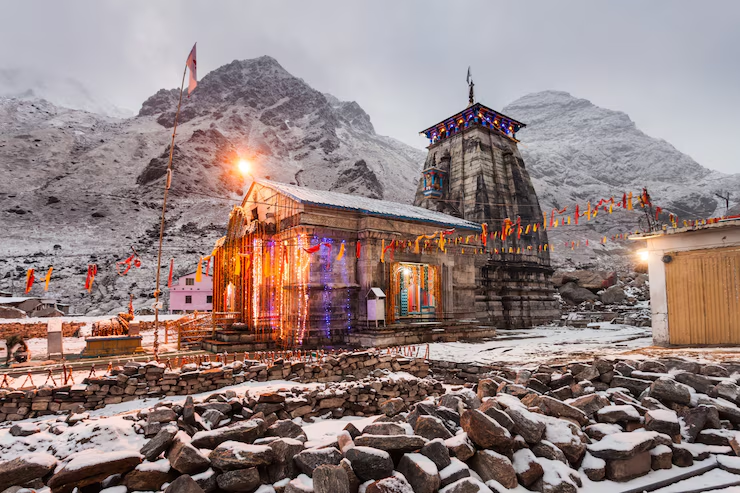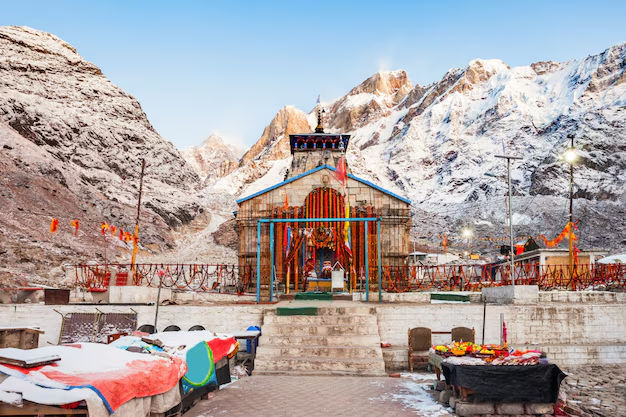Kedarnath Temple: A Sacred Jewel in the Himalayas

Introduction
Kedarnath Temple is one of the most revered and ancient Hindu temples in India, dedicated to Lord Shiva. Nestled in the Garhwal Himalayas of Uttarakhand at an altitude of 3,583 meters (11,755 feet), the temple is not just a religious destination but also a symbol of resilience, spirituality, and architectural marvel amid nature’s raw beauty. It is one of the twelve Jyotirlingas and forms part of the Chota Char Dham Yatra, which also includes Yamunotri, Gangotri, and Badrinath.
Historical Background
The exact origins of Kedarnath Temple remain a mystery, but it is widely believed to have been originally built by the Pandavas from the Mahabharata era. According to legend, after the Kurukshetra war, the Pandavas sought Lord Shiva’s blessings to absolve themselves of their sins. Shiva, however, eluded them and took the form of a bull (Nandi). When discovered by the Pandavas, Shiva dived into the ground, and his hump appeared at Kedarnath. The present structure was later believed to have been reconstructed by Adi Shankaracharya in the 8th century C
Architecture and Design
Kedarnath Temple is built from large, grey stone slabs fitted tightly without the use of mortar, a testament to the architectural skills of ancient India. The temple is built on a rectangular platform and features a conical stone tower, a mandapa (hall), and a sanctum where the lingam (the symbolic form of Lord Shiva) is housed.
Despite being located in a region prone to harsh weather and natural calamities, the temple has withstood the test of time. Its massive stone walls, cold climate, and sturdy construction have helped it endure for centuries.

Spiritual Significance
As one of the 12 Jyotirlingas, Kedarnath holds immense significance for devotees of Lord Shiva. The Jyotirlingas are believed to be self-manifested shrines of Shiva, each representing a unique manifestation of the god. Kedarnath is considered the highest among these, both geographically and spiritually.
The lingam in Kedarnath is irregular in shape and believed to be the hump of the bull-form of Shiva. Devotees believe that a visit to this temple leads to liberation (moksha) and the washing away of all past sins.
https://sypertimes.com/tea-farming-in-india-a-glimpse-into-the-green-gold/
The Kedarnath Yatra
The journey to Kedarnath is a test of physical endurance and spiritual devotion. The temple remains open to pilgrims only between late April and early November due to extreme winter weather. During winter, the idol of Lord Shiva is moved to Ukhimath for worship.
The pilgrimage typically begins from Gaurikund, the last motorable point. From there, devotees must trek about 16 kilometers (now also accessible via helicopter or pony rides) through rugged mountain terrain. The trek is steep and demanding but offers breathtaking views of snow-capped peaks, alpine meadows, and gurgling rivers.
For many, the journey itself is a deeply transformative experience, filled with chants of “Har Har Mahadev” and shared stories of faith.
2013 Flash Floods and Aftermath
On June 16–17, 2013, Uttarakhand witnessed one of the worst natural disasters in its history due to unprecedented rainfall and glacial burst, causing flash floods and massive landslides. The town of Kedarnath was severely affected, and thousands of lives were lost.
Miraculously, the Kedarnath Temple stood intact despite the destruction all around. A massive boulder behind the temple diverted the deadly floodwaters, sparing the sanctum from damage. Locals and devotees alike regard this as divine intervention. The boulder is now revered as “Baba Bhairavnath’s protection.”
Following the disaster, the temple and surrounding infrastructure underwent major restoration under the supervision of the Indian government and various spiritual organizations. Today, the pilgrimage route is safer, and the region has seen a strong revival in tourism and religious activity.

Weather and Accessibility
Kedarnath is accessible only for about six months a year. During winter, the temple is covered in snow and closed to the public. The best time to visit is from May to June and September to October. Temperatures can drop below freezing even in summer, so pilgrims must be well-prepared for cold and unpredictable weather.
Various helicopter services and improved road connectivity have made the temple more accessible than ever before, especially for elderly pilgrims.
Bhairavnath Temple
Just about 500 meters uphill from Kedarnath Temple is the Bhairavnath Temple, dedicated to Bhairava, a fierce manifestation of Shiva. According to local belief, Lord Bhairava guards the Kedarnath shrine during the winter months when it remains closed. Visiting Bhairavnath Temple is an essential part of the pilgrimage for many devotees.
Environmental and Cultural Concerns
With the rise in pilgrim traffic post-2013, there has been growing concern about environmental degradation in the fragile Himalayan region. The government and NGOs have taken steps to promote sustainable tourism by limiting the number of daily visitors, banning plastic, and improving waste management systems.
Additionally, efforts are being made to preserve the local Garhwali culture and traditions that form an integral part of the Kedarnath experience.
Conclusion
Kedarnath Temple is more than just a religious site; it is a spiritual beacon that attracts pilgrims from across the globe. Its resilience in the face of natural calamities and its divine aura make it a symbol of faith, strength, and devotion. A visit to Kedarnath is not only a journey through the majestic Himalayas but also a path inward, to the soul of India’s spiritual heritage.




